…and Counting
Posted in: Uncategorized

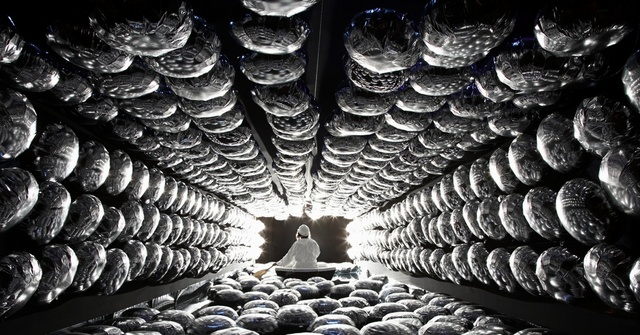
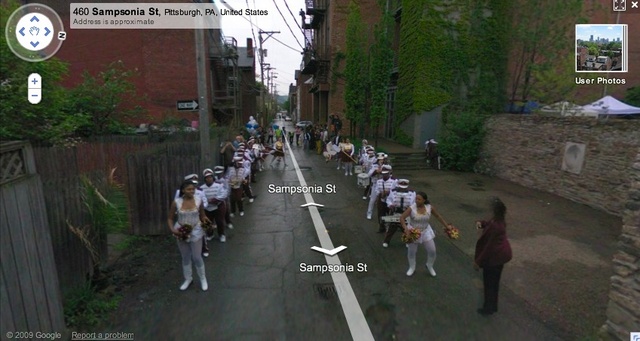
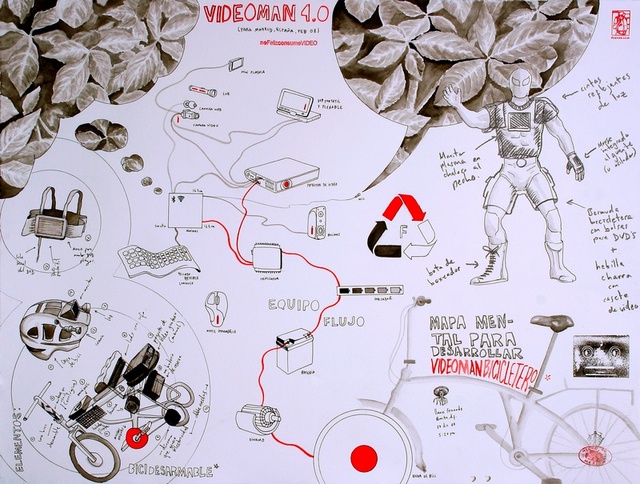
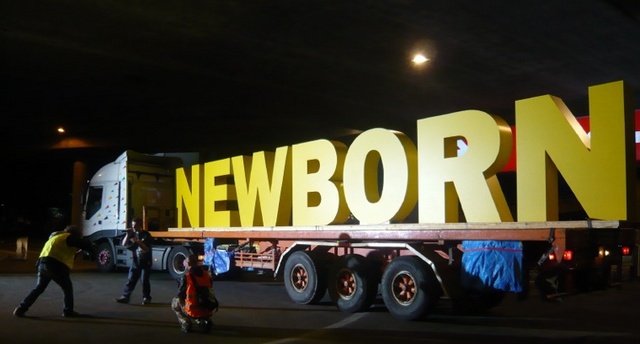

Back in October 2007, Rob O’ Copp was fined £30 by a Police Community Support Officer (PCSO), for cycling a short distance across the pavement towards a cycle stand in Nottingham City Centre, in England.
Although their uniform is deceivingly similar to that of police officers, PCSO do not belong to the Police Federation, the staff association for all police officers. Their powers are very limited but citizens might not know it. For example, PCSOs have the same powers of arrest as other ordinary citizens. They cannot detain any ‘offender’ for more than 30 minutes. Their job is to deal with low-level disorder and anti-social behaviour, leaving regular police officers to concentrate on more serious crimes. More generally, PCSOs patrol the street to reassure communities by their high-visibility presence.

His mis-adventure with a PCSO inspired Rob O’Copp to set up PCSO Watch project. Along with a fellow undercover agent, he gave us a glorious and entertaining presentation of their activities at the Radiator festival a couple of days ago (proper report will follow, at least that’s the plan) .
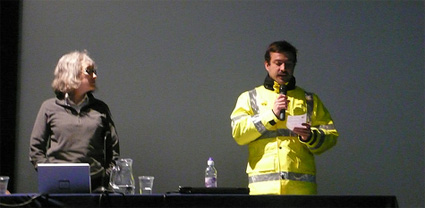
PCSO Watch project has declared that ‘We are all Police now’ and launched the The Office of Community Sousveillance operation. ‘Sousveillance officers’ have spent several weeks collecting information, data, and stories about PCSOs and the Community Protection Officer (CPO). During the Radiator festival , they are operating from a mobile field unit placed temporarily in hotspots around the city. The unit is in fact a caravan stationed legally in the center of Nottingham. Wearing a fluorescent jacket similar to the one PCSOs and COPs don and occasionally putting on a mask in the shape of a CCTV camera, they patrol the streets of Nottingham keeping an eye on the ones who keep an eye on the whole city.
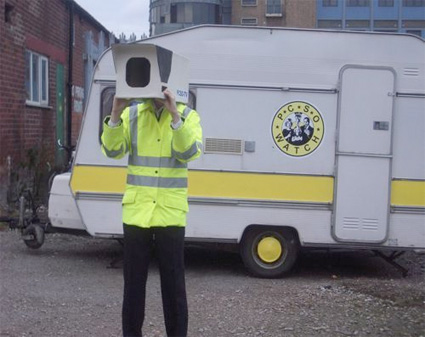
The Office of Community Sousveillance is asking for your help in contributing your stories about PCSOs and their Community Protection Officer (CPO) colleagues, stories will be added to their blog.
Members of the public who would like to be interviewed anonymously or wearing a disguise for a video archive are invited to contact: Officer Rob O’Copp at The Office of Community Sousveillance
email rob.ocopp@yahoo.co.uk
phone 07530 946082
On view at Surface Gallery and in the streets of Nottingham through January 24, 2009.
All i knew about Jordi Colomer before entering his solo show at Le Jeu de Paume in Paris was his Anarchitekton series, i was prepared for the absurd. I didn’t know the absurd could make so much sense.
Colomer’s video installations focus on the contemporary city and in particular on the influence of urbanism on human behaviour. They toy with fake actors in real situations, fictions set in barren landscapes, artificial spaces, urban simulacra and architectural narratives. Behind their humour and irony, his productions never fail to reveal us something about the sociological and psychological dimensions of his subjects.
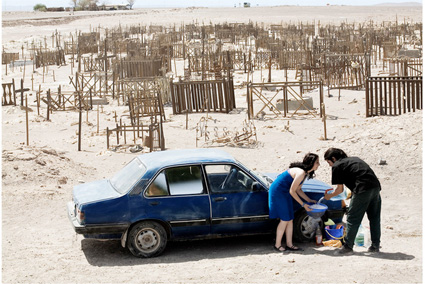
Jordi Colomer, En la Pampa (Cementerio Santa Isabel), 2007-2008. © ADAGP, Paris, 2008
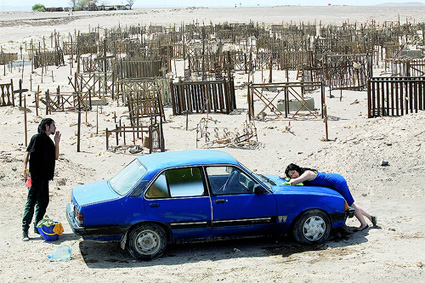
Jordi Colomer, En la Pampa (Cementerio Santa Isabel), 2007-2008. © ADAGP, Paris, 2008
Colomer’s aesthetics and architectural explorations pervade the whole exhibition. The videos are screened onto wooden panels, or in some makeshift structures, there is a battered trailer in the middle of one of the exhibition rooms and a mix-match of what looks like second-hand chairs are aligned against the walls.
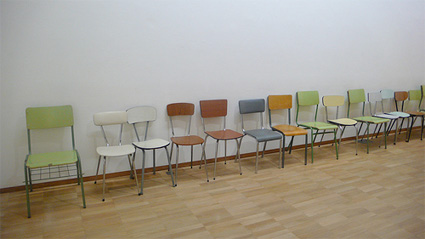
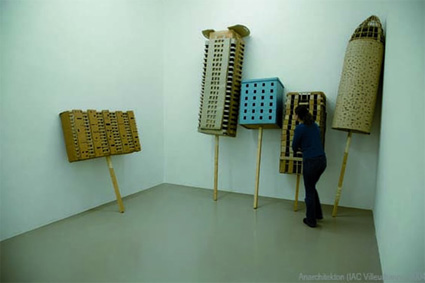
Models of the buildings used for the Anarchitekton performances, as displayed at the MACBA in Barcelona
Pozo Almonte, a body of works which was produced for the Paris exhibition, is a moving trip to one of the few surviving mining towns exploiting saltpetre (potassium nitrate) in the Atacama desert in Chile. Instead of documenting what was left of the mining activity, the artist went to the cemetery and photographed its constructions. Each of them looks like a small house that redresses the builders’ meagre resources with inventiveness and personal creativity. Architecture without architects at its best. As Colomer explains: The cemetery is a sort of parallel city, well and truly alive, and full of thoroughly terrestrial little houses. It is an area shared by the living and the dead, where the latter seem to be merely on holiday. And yet this family architecture also looks like the decor of another world…
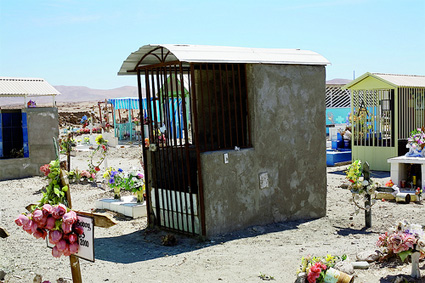
Jordi Colomer, Pozo Almonte, 2008. Production Jeu de Paume, Paris. © ADAGP, Paris, 2008
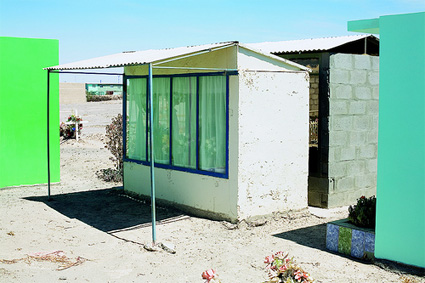
Jordi Colomer, Pozo Almonte, 2008. Production Jeu de Paume, Paris. © ADAGP, Paris, 2008
The Pope’s protective vehicle, the Popemobile, is an icon that has traveled all over the world. Says Colomer: I wanted to put this highly meaningful image back into the street ? in three-dimensional form but disencumbered of its Vatican pomp, with the nakedness of a prototype ? so as to record the reactions of passers-by. The Popemobile’s sacred dimension being already somewhat slight, it was chiefly a matter of desecrating its spectacular side and leaving only the bare bones. It was first and foremost a pretext for portraying a heterogeneous group of people, conjuring up a setting, creating a situation and just letting things happen… What kind of people were going past at noon on that summer day in 2005 in the fast-evolving area of Barcelona that lies along Diagonal Avenue in the Poble Nou district?
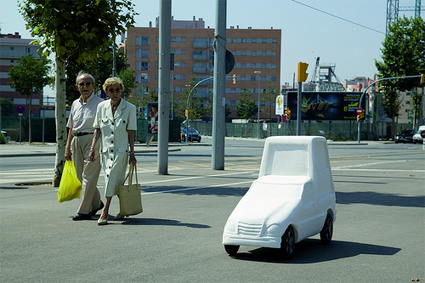
Jordi Colomer, Papamóvil 2005. Extrait du diaporama. © ADAGP, Paris, 2008
En la Pampa is an attempt to find whether there is a place on earth that can ‘resist fiction’. A man and a woman, chosen because they are not actors, are left free to perform all sorts of activities and discussions in the Atacama desert in Chile. Viewers quickly realize that the mere presence of the camera turns the experiment into a fiction that contaminates the desert itself.
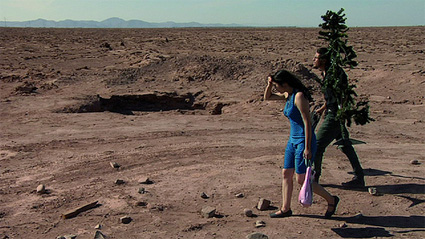
Jordi Colomer, En la Pampa (Vagar en campo raso es…), 2008. © ADAGP, Paris, 2008
Anarchitekton is a series of videos produced over two years and starring a quizzical personage called Idroj Sanicne. The films shows him cavorting around Barcelona, Brasilia, Osaka and Bucharest, brandishing cardboard models of buildings that are visible in the background. By doing so he stretches the boundaries of architecture, highlights its ‘backdrop’ character, drags reality into fiction and gains the attention of passersby in the process. Sanicne’s performance evokes moments of angry protests, popular parades but also religious processions.
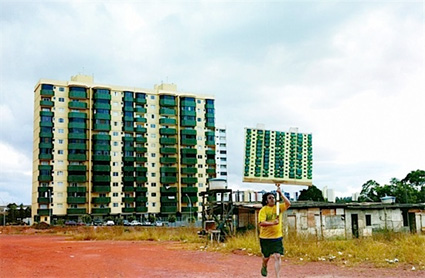
Jordi Colomer, Anarchitekton, Brasilia, 2003
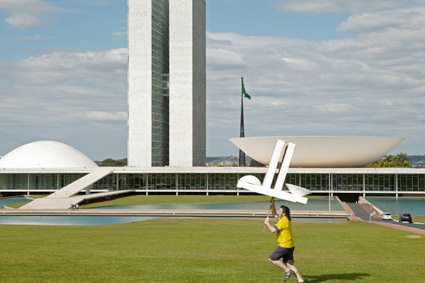
Jordi Colomer, Anarchitekton, Brasilia, 2004
The work of Jordi Colomer is on view at Le Jeu de Paume in Paris until January 4, 2009.
Heidi Kumao‘s art pieces explore ordinary social interactions in order to reveal what lies beneath them: psychological states, emotions, compulsions, thinking patterns, and dreams. She is currently teaching animation, video, experimental television production, and electronic and conceptual art at the School of Art and Design at the University of Michigan, Ann Arbor. For 2007-08, she has been awarded a Postdoctoral Research Fellowship from the American Association of University Women Educational Foundation.
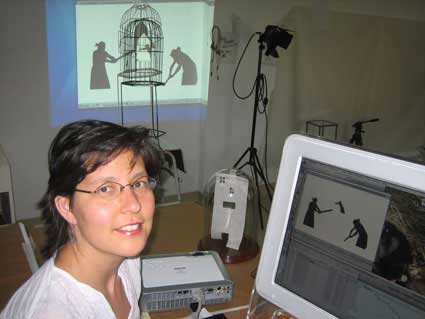
A few years ago i discovered her set of female kinetic sculptures “Misbehaving: Media Machines Act Out,” and classified her work under robotics and kinetics. Then i stumbled upon the performative techno-enhanced series of clothing she had developed and here i was trying to fit her work inside the “wearable” category. A closer look on her portfolio revealed household objects sabotaged to become cinema machines, overtly activist projects and the geekiest wedding cake i had ever seen. The experience taught me that any attempt to classify of her work would be pure folly unless i’d try to trick her into giving me a helping hand:
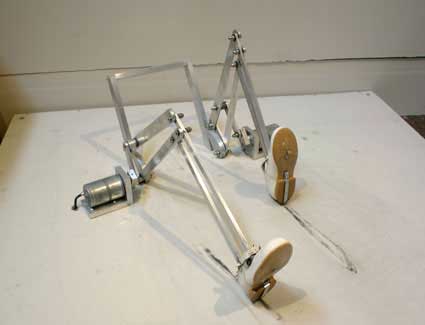
Resist, 2002
You first graduated in photography at the School of the Art Institute of Chicago. How did you come to work with kinetic installations, RFID activist projects and quirky wedding cakes? What made you broaden the scope of your artistic practice?
This is a big question, so I’ll answer it in sections as a way to answer the larger issue of shifts in artistic practice. How I get from here to there to there to there…
Re: transition from photography to sculpture
The Art Institute had a very interdisciplinary photo department at the time and we were really encouraged to “go outside the box” of photography, to mix photography with other media, to be artists who USE photography rather than pure photographers. In the 80’s and 90’s, photography was exploding in 100 different directions and open to a variety of approaches. Everything was possible. Everything could be photographic in some way.
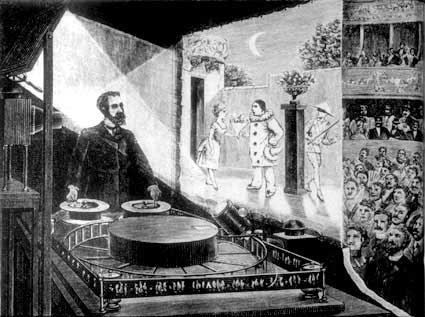
When I entered graduate school as a photographer I was already starting to work with sequential imagery. I was driven by a need to animate physical gestures and behaviors as indicators of psychological states. Simultaneously, I was collecting domestic objects and record players and researching pre-cinema devices and the 19th century creation of spectacle, Emile Reynaud‘s praxinoscope from the 1880’s, in particular. My first kinetic works were homemade-looking zoetropes that projected a sequential loop of 12 images: a child being spoon-fed, a woman’s legs curtseying, a woman frantically sweeping. Like a memory that can’t be repressed, each animated sequence repeated endlessly and mechanically. In this way, each object seemed to be speaking with its images, a visual and mechanical voice replacing text. Much like the girls’ legs I made much later, they were an artificial life form, a stand-in for a real person that I could construct and bring life to. These “cinema machines” (as I called them) allowed me to combine all of my interests (photography, performance, sculptural assemblage and the psychology of everyday life), into one art form. I loved working this way and continued to create cinema machines for several years.
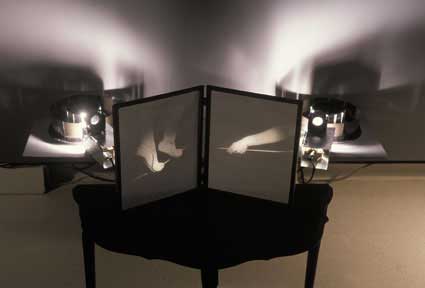
Defense Mechanism
RE: Installation
While much of my work could be categorized as “kinetic installation,” a more accurate descriptor might be “animated tableau.” I tend to think of myself as a theater director, staging events for the viewer. A lot of my art practice is about creating a situation for something to unfold over time. This grew organically out of my experience staging photographs. It seems to be a mode of art making to which I am intuitively drawn.
Each tableau intentionally uses recognizable objects that suggest a possible scenario from everyday life. As I craft each piece, I am very conscious of the psychological experience that is created for the viewer. Can the space of each tableau imply both a physical site and a psychological state? How can I make the viewer re-examine seemingly ordinary events such as childhood play, family dynamics, television news or even the wearing of clothes?
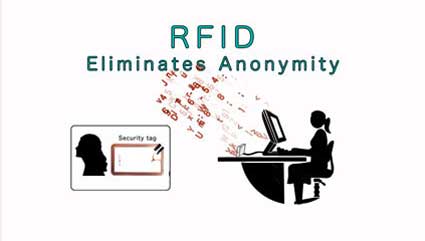
Still from Zapped! video
RE: RFID Activist projects
I worked on Zapped! a multi-part project about the mass implementation of RFID technology with Preemptive Media in 2005. I met the members of Preemptive Media (Beatriz da Costa , Jamie Schulte, and Brooke Singer at Carnegie Mellon University in Pittsburgh, PA where I was a Microsoft Artist-in-Residence Fellowship for 1999-2000. Besides being a great school for robotics, computing, AI, engineering and art, Pittsburgh happened to be an amazing hub for art collectives, tactical media practitioners, and technological art at that time. I was surrounded by tons of brilliant people including folks from Critical Art Ensemble, Institute for Applied Autonomy, and Subrosa, to name a few. Just being in this environment made me rethink my artistic process completely, and motivated me to learn how to incorporate electronics, microprocessors, computing, and digital imagery into my work.
Before we ever did Zapped! a few of us had collaborated on a project (Nomadika) about data-veillance and wireless technologies for the 2001 Sculpture Conference in Pittsburgh. We educated and informed the public about the future of data mining by opening a storefront for our fake marketing firm. Researching data mining and privacy loss in our contemporary era later led Preemptive Media to the project on RFID, which seemed to be (at the time) yet another way in which corporations and the government would invade citizens’ privacy. As someone who creates and teaches animation and video, my primary role in the collaboration was to make the educational video from all of the research and information we had unearthed as a result of this project.
After working solo for so long, I relished the opportunity to collaborate with others on a project.
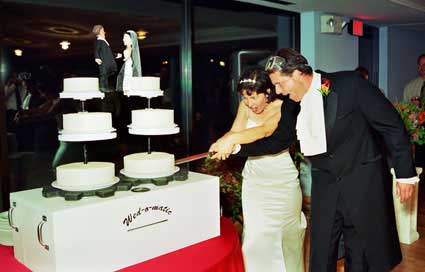
RE: quirky wedding cakes
The 6,000 volt wedding cake was a collaborative project with my husband, Michael Flynn, a high school physics teacher and science exhibit designer. As two mechanically minded people, we decided that our cake had to reflect our interests in machines and the project grew from there. It started with the idea to have two cakes cut to look like interlocking gears and progressed to two motorized cakes on gear-run platforms. Michael made two dolls that represented us in our wedding costumes. These dolls were going to stand on the top of each cake and would basically pass one another every time the cakes turned. Eventually, I thought we needed to incorporate an electric “spark” between the dolls, like the “spark” between us (cheesy, I know). This led to the idea of using a Jacob’s Ladder to generate a much larger spark. Michael purchased a neon sign transformer and wired the cakes and dolls with opposing charges. When powered on, the cakes turn, and once a turn, the dolls hands meet and a large flaming spark erupts from their meeting hands. It’s pretty funny. And like other collaborative projects I’ve done, it was loads of fun!. Our “how to” article appeared in Make Magazine.
What made you broaden the scope of your artistic practice?
When I look over the various transitions I have made with respect to media
(from photo to cinema machines to kinetic sculptures to animation to collaborative technological projects), I can map those changes onto personal and cultural moments of change. For many years, I made a life as an artistic nomad. I relocated every year or two for jobs, fellowships or other opportunities. This experience of having to re-contextualize and refocus myself in so many different places shaped my art practice in a deep way. Each time I moved, the new school, city or community raised new issues to consider. For example, (like I said earlier) as a research fellow at Carnegie Mellon, I was exposed to art practices that critically engaged technology rather than simply used technology. I had access to people, tools, and resources such as machine shops for the creation of custom parts, computer programmers, robotics labs, video editing equipment, etc. As a result of being at Carnegie Mellon, my work shifted away from more personal themes towards more political issues and cultural critique.
While I had been using technology for many years, my time at CMU caused me to rethink how I used it and why.
Exposure to such a large computing environment had other long-term effects on my art that didn’t show up until much later. Researchers in AI, computing, robotics and gaming exposed me to the possibilities of generative artwork, which was a complete paradigm shift from creating “fine art” objects for the art world. I was excited to think about making a dynamic system or a tool as an artwork rather than a fixed object. However, it took me awhile to decide on a project that would best be served by this approach.
Later, when I moved to Ann Arbor, Michigan, 9-11 and the proliferation of cable news caused me to analyze the visual and conceptual construction of the news broadcast more critically. CNNplusplus, an interactive and dynamic news broadcast, was born a few years later (in collaboration with Chip Jansen.
Video:
The short answer to your question is simply new places, new people and A.D.D. or the tendency to get bored easily…
You seem to navigate effortlessly from one discipline to another but are there particular issues or elements that you keep returning to?
Yes! I find that I return to an exploration of ordinary social interactions and their psychological undercurrents, institutional critique (mainstream media, traditional gender roles, others), and performance (creating theatrical spectacle, behaving/acting social roles, performing for a camera). I view performance as an integral part of everyday experience and define it very broadly: as a means to define our identity and sexuality, as an examination of roles we play as employees or family members, and as a tool for self-expression. Every piece has its origins in everyday life: an argument, a memory of childhood, the frustrations of watching television, the act of being a consumer–
My art making process is grounded in these types of experiences.
Combining these three things together has produced two main types of work that are pretty different (at least to me):
1) Work that emphasizes a visceral experience and tells a more personal story: the “cinema machines,” the girls’ legs, stop-motion animations, and my latest shadow theater pieces
and
2) interactive projects that are more overtly political and use technology to critique technology: CNNplusplus, Zapped!, Wired Wear
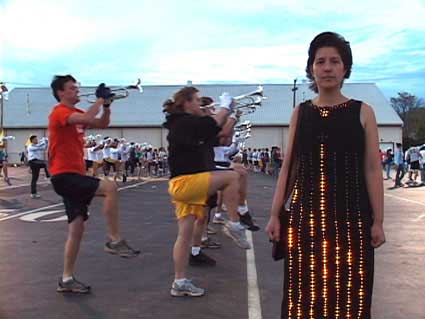
Monitor II: Audio-activated Dress, 2005
I find I am drawn to the more personal works because they provide an outlet for me to imply/suggest a critique of institutions of power without being so literal. Almost every piece starts with a personal story of some kind and the creation of a tableau is an opportunity to create a visual poem of images and objects together. By exposing the physical apparatus that drives the bodies into action, I draw a parallel between this machinery and the mechanisms of our unconscious: defense mechanisms, sex drives, thinking patterns, self control, dreams, impulses, instincts.
With the public/interactive projects, the emphasis is more educational and/or ironic. Working collaboratively removes the personal emphasis and creates opportunities to address larger cultural issues and their effects on the general public.
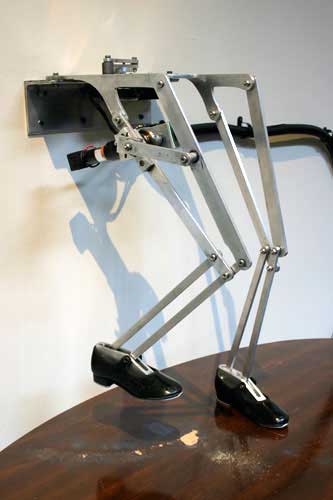 Misbehaving is a series of three female “performers” for intimate installations. What is the performative part of the work?
Misbehaving is a series of three female “performers” for intimate installations. What is the performative part of the work?
Misbehaving consists of three pairs of aluminum, mechanized legs fitted with girl’s shoes: Protest, Resist and Translator. The legs in Protest stomp loudly and unpredictably while standing on a coffee table. In Resist, a pair of girl’s legs squirms on the floor in a way that is both sexualized and challenging in response to viewers’ speech. The girl in Translator is trapped on a track between two “adult” chairs with video projectors for heads. As viewers hand crank her from one side to the other, she becomes like a child caught between two feuding parents, or a political mediator, whose body/screen reveals/exposes the real text of the conversation through non-verbal gestures.
With these pieces, I was thinking about the performance of gender, especially for little girls. We learn what is appropriate behavior so early that it becomes naturalized, we don’t realize that we perform it. In developing these pieces, I wanted to intentionally create girls that perform “badly”, act out, misbehave, or act against type. As machines and girls, these works operate in stark contrast to a culture obsessed with “increasing job performance,” high performance cars, and athletic performance. Their acts of defiance are small, yet powerful, signs of agency.
Videos:
The kinetic girls legs have also some feminist (may i use that word?) undertones. Why is it still important to propose a view on feminism today?
YES, you may (and SHOULD) use the word “feminist.” I consider myself a feminist and I think the stigma around the word (created by conservative males) has (unfortunately) had its prescribed effect of preventing people from self-identifying as feminists.
Those legs were born out of my experience at Carnegie Mellon where I was surrounded by really macho robots: machines that can fight fires or repair a nuclear reactor, robots for combat, robots for Mars, etc. At the same time, television programs were priming the mainstream public for what I call “performative robotics,” including BattleBots and Robo-wars, as vehicles for violent entertainment. With technological art and computing still so male dominated, and the research funding driven by the Defense Department, I do think it’s important to remind ourselves that robotics has a range of applications that are social, psychological, poetic, beautiful, and quirky. Are those feminist, or just alternatives to the mainstream?
I think it’s important to maintain a vigilant feminist critique of the world in the same way that it’s important to be vigilant about racism and economic justice.
A couple of years ago you developed Zapped! together with the other members of Preemptive Media. The work examines the mass deployment of Radio Frequency Identification (RFID) and its effects on our everyday activities. At the time the website of the project said that “RFID is not yet a household name or a pervasive technology, but Preemptive Media predicts that everyday encounters with this technology (whether known or not) will soon be commonplace.” How much has changed ever since? How much is the public aware of the possible downsides of RFID technology?
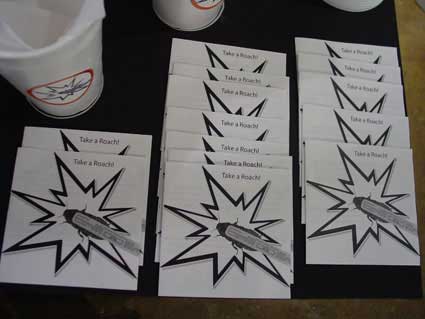
In October 2006, the US started issuing passports with RFID chips that include a digital photo and all other information currently printed in passports. These passive tags in passports are only a small beginning of all-around use as they can be embedded into nearly everything you buy, wear, read, or drive. At the time we did the piece, there was a common fear of surveillance–that by carrying items with tags, you could be tracked, your personal data could be compromised, etc. The reality is that the tags need to be scanned at such a close proximity (a few millimeters) that it’s difficult for someone to scan your item without your knowledge. Plus, if all the tag has is a reference number (for another database) rather than concrete data, there isn’t much to gain by secretly scanning…In general, as with so many of these new technologies (GPS, for example), people choose convenience over privacy. In our current climate, you can’t have both. We all love the convenience of having a cell phone, even though they all have GPS chips. You don’t hear people complaining about the possibility of being located through triangulation of their cell phone chip. At least not yet. I think that data privacy is the new “civil rights” issue of our time–at least in the US where there aren’t many data privacy laws.
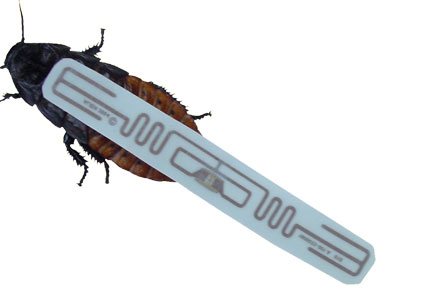
I’ve always been fascinated by the story of the roach release. I saw a brief mention of it a newspaper one day. Can you explain us what it was about and in which context it took place? But also, how did the public react to the idea?
The roach release was but one part of the Zapped! project. The multi-part project included the educational video, a school kit for “arming” yourself against RFID surveillance, the roach release station, and educational workshops. Each of these reached a different segment of the population with the goal of not only informing the public about the technology, but also providing them with means with which they might take action against it.
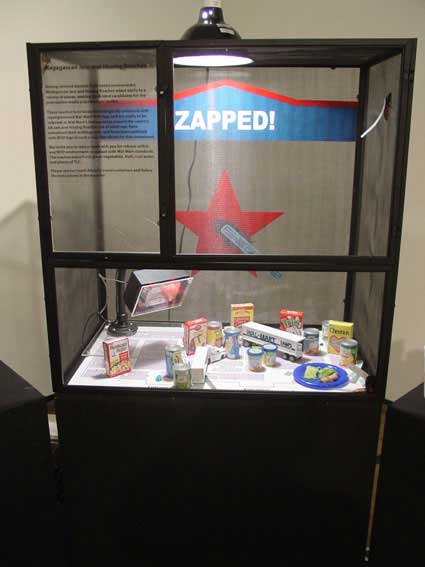
At the time, WalMart was setting the standards for RFID implementation by requiring its top manufacturers to embed tags into the cases and pallets of merchandise. As the largest retailer in the world, its protocol affects the business practice of nearly everyone in merchandising. WalMart pushed for this change touting its increased inventory efficiency. At this point, we speculated that if a WalMart had RFID readers and a corresponding database, they would all be located in the loading dock/storage area of the store. We discussed different ways to use or subvert the signal of the WalMart RFID reader- for passive tags, it sends a small signal in order to read the information on the tag and puts that information into a database. As we went round and round with ideas for tricking/toying with this Goliath, the idea boiled down to creating a small interruption in/jamming the WalMart RFID database. If WE couldn’t gain access to the loading dock and the readers, perhaps we could send a robot, or, as Beatriz da Costa suggested, a rodent or insect in our place. The final solution was to send a cockroach (with an preprogrammed RFID tag glued to its back) into the store’s loading dock area. The RFID tag was programmed with a small text message of resistance–and would definitely cause a “hiccup” in a database that was accustomed to standardized product information. In the video, we gave instructions on how to do a “roach release,” and in Houston (at Diverseworks), we gave away all the Zapped! roaches. I am not at liberties to say anything about the actual release. The public loved the idea and the roach became the project’s mascot.
Video:
Any other Wal-Mart action?
Not with that piece.
What was the impetus for the audio-activated DRESS? How do you exhibit it (or any of your other wearable pieces for that matter)? As part of a performance? As a static piece in a gallery? As a garment you can lend to gallery-goers?
The wearables started as an idea for a fun Halloween costume. I was initially inspired by the humor that could result from providing visual feedback, especially on a woman’s body. The lights on the dress light up incrementally, starting at the bottom when the sound is softer, and lighting up the entire column when it becomes very loud. When I wear the dress, I become a walking audio-meter which is really an absurd (and poetic?) image. These pieces are custom made to fit my body, and I use them in humorous video performances. The project is less about the objects and more about what I can do with them. So far, I have exhibited them as objects on mannequins with a video that shows them in use. In the end, the final product is really the short videos. There are many more places I can take them…
You seem to be attracted by the idea of “intimacy”. Which one of your works expresses the idea better and why?
As an artist, I use machines, projected imagery, and animation because they offer me a visually compelling way to investigate what is unseen: psychological states, emotions, compulsions, neuroses, desires, dreams. I find that I naturally gravitate towards work that examines everyday behavior and personal issues. I’ve called my work “intimate installation” because of its scale (human sized objects), its content (domestic and interpersonal issues) and its viewer experience (dark or dimly-lit rooms). With a minimum of objects, each tableau recreates a private ritual or occurrence for the viewer. I use the word “intimate” to describe the spaces I create and to draw a distinction between my domestic theaters and other large-scale environments.
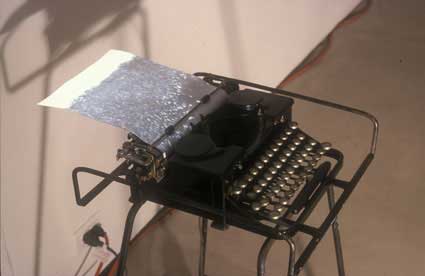
“Letter Never Sent” is a good example of this. In this piece, video footage captured under a dissection microscope is projected onto the space of the typewriter page. Sounds of a woman weeping, a doorbell ringing, and someone knocking on the door are juxtaposed with black ink creeping up the page and fading, and turbulent, dirty water which seems to spit out from the base of the typewriter. With this piece, I was trying to describe one woman’s difficult experience of writing a letter that is erased or never sent because it is too harsh, too truthful. Rather than use words, I used fluids, like emotions, to wash over the page like a wave. The page is filled and emptied again and again, similar to how one might write and edit oneself in pursuit of the perfect correspondence. Even though the work explores one person’s intimate experience, I think we can all relate to written communication, self-censorship and the strong emotions that result.
Yet another video:
You are also teaching at the University of Michigan School of Art and Design. What are your courses about? Can you give us a few examples of your students’ projects?
At this University, I am mostly teaching animation, video and various conceptual classes (this fall, an introductory class on TIME!). The most enjoyable courses focus on creating material for “experimental television broadcasts,” and rethinking the space of the television as an art gallery for time-based work. I know it seems like an old idea since video art first emerged as an alternative to mainstream television, but here at the University of Michigan, we have a unique collaboration with our local PBS station, WFUM. PLAY is a “collaborative project from the University of Michigan School of Art & Design and Michigan Public Media, transforming the gallery space for time-based media.” This project features time-based work (video, animation, documentary, performance, other experimental forms) by faculty and students in the School of Art and Design. Selected pieces air on television as interstitials-in between programs at the top of the hour, say between “The NewsHour with Jim Lehrer” and “Antique Roadshow,” while all submissions are viewable on the web. In my class, “Animation for Broadcast,” students get real-world experience producing fun promotional pieces as well as content (under 3 min.) for this gallery space we call a television. You can see some of their promo animations here. They were encouraged to think about the concept behind PLAY Gallery (an online, virtual place for art, television as gallery space) and play (the activity). They were given the PLAY logo and could do just about anything with it.
I think it’s a really great moment in history to reconsider what television and broadcast can be, do, say: with the YouTube-ization of the world, everyone’s a performer, everyone’s a filmmaker. How does that impact what we make and produce?
Any upcoming project you could tell us about?
I’m working on some totally new and different works. “Timed Release” is a series of performative portraits focusing on people who have developed a creative mental space to survive physical confinement. Paper cutouts and small kinetic sculptures contained in bell jars or other containers are brought to life through video projection to create illusionary shadow theater. It’s an engaging hybrid of image and object…
Thanks Heidi!

BBH and GT have released the newest bit to the Audi RS6 Campaign I wrote about a few weeks back (with the gymnasts), this time in the form of an impressive microsite. In addition to showcasing the gymnastics ad, complete with a decent making-of video and downloadable wallpapers, it showcases the RS6 (as a good auto site should) in all it’s glory, and with a great interface. The audio, video, and navigation come together to create a pretty impressive microsite. Definitely worth a browse, even if you’re not a big automotive fan.
The reason for my presence at etech08 this year was the “art fest” that i set up with the super nice and super smart Kati London, an itp graduate who currently works as a senior producer at area/code in New York and as an artist responsible for projects such as Botanicalls Twitter DIY and You Are Not Here.
Brady Forrest had the idea to organize this first ETech Emerging Arts Fest and we are infinitely grateful to him. We had our friendly debates and doubts but he is the first person who listened to our complains that artists should be given a voice in all those big technology conferences. The theme of the event was “Awareness” and we selected works that bridged the gap between perception and understanding. In retrospect i realize that Brady selected the geekiest pieces, Kati (who actually did most of the work) chose the playful ones and i went for information visualization.
Kati and i invited Brooke Singer to join us for a panel which attempted to illustrate the whole idea of awareness to the conference attendees. Because i’m never really interested in writing about my own presentations and because i’ve covered the work of Brooke several times (and will keep on doing so in the future), i’ll just focus on Kati’s talk.
She gave me the authorization to publish her slides so here they are:
And here the notes i took while she was talking:
She compared artists to hackers, they are the one giving the one finger salute to mainstream technology, they have ideas, go against the grain and keep on pushing their own inspiration forward no matter the resistance.
Today, we have more and more tools which empower people: OS hardware and software, library, there’s also a revival of the DIY culture, Arduino and Processing are increasingly successful, etc. Suddenly being creative with technology becomes possible for a larger number of people. How does this spirit translate when we think about “awareness”?
Kati then focused on several projects which, according to her, best embody the idea of awareness.
1. Invisible: Waste processes
drinkpeedrinkpeedrinkpee, by Rebecca Bray and Britta Riley, includes an installation and a diy kit for turning your pee into fertilizer for houseplants.

What happens when we think of our bodies as their own ecosystems? Are they open or closed ecosystems? Where do we draw the boundaries? Before we take medication, do we ask ourselves how it will affect our internal organs, our friendly bacteria? What is our medication’s future, beyond our bodies, in the sewage system and out in the waterways we swim in and eventually drink? What are the possible futures of our personal waste? What do sentient ecosystems eat and drink?
Human urine is actually sterile (unlike faeces, it is bacteria-free) and it can be a rich food source if it gets into the right part of the right ecosystem. Now, most human urine travels untreated into the waterways and is a significant cause of eutrophication, a toxic condition caused by harmful algae blooms, in the oceans. The excess nitrogen and phosphorus in our urine overfeeds algae and suffocates fish.
However, a biological waste treatment process developed at EAWAG Aquatic Research in Switzerland can extract this phosphorus & nitrogen for use as a fertilizer, leaving the rest of urine almost harmless to aquatic life. This kit gives users the opportunity to replicate the technique at home and fertilize their plants with their own pee.
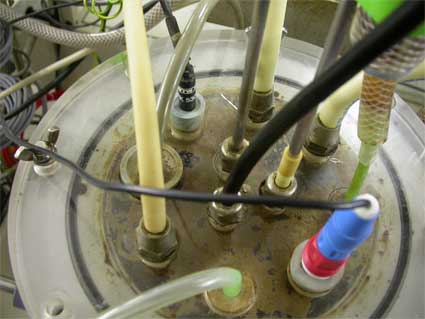
Bioreactor to stabilize urine, photo Eawag
The installation will be on view and the DIY kits will be available at the exhibition FEEDBACK at Eyebeam, March 13 – April 19, 2008.
2. Invisible: Animal Behavior Patterns
Joshua Klein built a vending machine that teaches crows to deposit coins in exchange for peanuts. Crows are surprisingly (for me) intelligent. Their brain/body weight ratios are similar to chimpanzees. Look at the image below, seagulls don’t get the vending machines but those smart little crows seem to understand that there’s something worth their attention there.
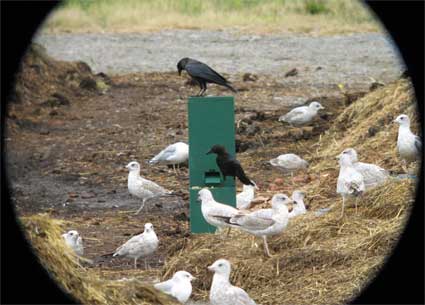
Once he has fine-tuned the vending machine training, his plan is to train crows for search and rescue, picking up trash, and other mutually beneficial tasks (via boing boing). The machine is only the first step in his quest for “interspecies harmony.”
3. Invisible: Social Connections
 Generative Social Networking, by Andrew Schneider and Christian Croft, uncovers the dark sides of social networks by exposing their vulnerability. The software uses bluesnarfing to open the mobile phonebooks of people using security loophole-laden Bluetooth devices. This phonebook data is then fed through the GSN System. Unbeknownst to the phone owner, the device betrays its list of phone numbers to a laptop. An Asterisk phone server will then generate a “conversation” with each number in the list. The first number on the list is called and receiver’s response recorded. The next number on the list is called, the first number’s initial response is played back to the new number, and the new number’s response to the old number’s prompt is recorded. This continues for however many phone numbers are in the contact list.
Generative Social Networking, by Andrew Schneider and Christian Croft, uncovers the dark sides of social networks by exposing their vulnerability. The software uses bluesnarfing to open the mobile phonebooks of people using security loophole-laden Bluetooth devices. This phonebook data is then fed through the GSN System. Unbeknownst to the phone owner, the device betrays its list of phone numbers to a laptop. An Asterisk phone server will then generate a “conversation” with each number in the list. The first number on the list is called and receiver’s response recorded. The next number on the list is called, the first number’s initial response is played back to the new number, and the new number’s response to the old number’s prompt is recorded. This continues for however many phone numbers are in the contact list.
More fun with the video.
Antony Hall‘s projects explore the way we interface with technology, and how our interactions with it influence us creatively and socially. Often collaborating with scientists and technologists, Hall is currently focusing his talent on the investigation of biological and physical phenomenon. Some of his recent experiments involve communication with an electric fish, the creation of life through growing crystals electrically on volcanic stone, hunting for Moss bears and training Planarian worms.
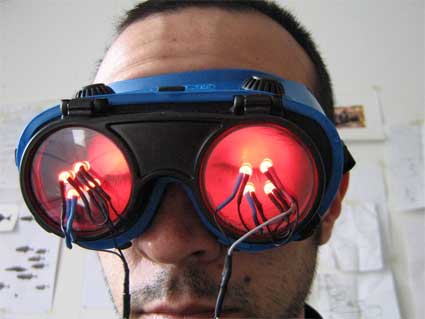
He gained fame in the media and media art festivals with his electro-acoustic sound art devices and performances. Together with Simon Blackmore and more recently Steve Symons, Hall is a founding member of the Owl Project, a group which combines woodwork with electronics to create performances, musical instruments (iLog , and Log1k) and other physical computing projects.
Let’s start with one of your most popular projects: the iLog. How did you get the idea of making it?
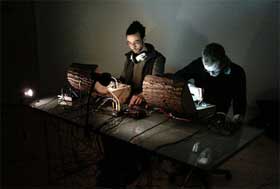 The iLog was created as collaborative project with Simon Blackmore and Steve Symons, we are the Owl Project. We developed the Log1K in 2001 as a performance tool to attempt rival the laptop in electronic music, shortly after this apple started pushing the iPod and we had to make a response, something which related more to the trend for portable, mobile hand held technologies. We wanted our devices to be a synthesis of craft and technology, as well as functional instruments. The Log1ks were getting increasingly heavy, among other things they used nearly 30 AA batteries, short circuits and fires, and blown-out speakers were becoming common place. iLog 01 came out in 2003. After we started collaborating with Steve Symons, we reinvented the electronics inside the iLog and started pushing the whole project to a new level; the M-Log is out later this year.
The iLog was created as collaborative project with Simon Blackmore and Steve Symons, we are the Owl Project. We developed the Log1K in 2001 as a performance tool to attempt rival the laptop in electronic music, shortly after this apple started pushing the iPod and we had to make a response, something which related more to the trend for portable, mobile hand held technologies. We wanted our devices to be a synthesis of craft and technology, as well as functional instruments. The Log1ks were getting increasingly heavy, among other things they used nearly 30 AA batteries, short circuits and fires, and blown-out speakers were becoming common place. iLog 01 came out in 2003. After we started collaborating with Steve Symons, we reinvented the electronics inside the iLog and started pushing the whole project to a new level; the M-Log is out later this year.

There’s now a series of iLog models. Why do you think people buy the iLog? Mainly as a beautiful and quirky piece of art which they would not use too much fearing that it might be damaged (although you provide technical support.)? Or have you found that people use it extensively as any other kind of musical device? Were you expecting your project to have so much success?
I suppose people want the iLog for its quirkiness, something as an alternative to the mass produced items. We had no idea that it would become so popular – people blogged it like mad at the start and like a Chinese whisper it suddenly became what people wanted it to be; typically some kind of alternative to the ipod – But in reality its something quite different. It is intended to be an instrument for performance.
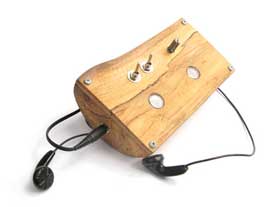
iLog signal
Our problem is that although there is demand; making them is still very difficult, and time consuming, so our focus is making them better rather than faster. At the moment we are looking at lending these to artists and working in collaboration to develop the iLog further. When we launched them for sale in London at DWB it was a real learning curve. Simple things like which way up it should be held, were completely un-obvious! We had to create extensive instructions regarding use, as well as repair and maintenance. The 24 hour support is most necessary! Its important that its more hands on than your average mass produced plastic device.
The iLog is something people can use, rather than living all its life in the art gallery. The new series, *M-Log, launching this year, looks like an iLog, and is a USB connective interface. So there is scope for programming your own sensor based instrument, which you can use with your own customized patch. The iLog is more of a stand alone sound generator. We are planning an event in Manchester during Futuresonic where other performers (including Leafcutter John) will be using the iLogs & M-Logs. *The M in M-Log stands for ‘muio’ as in “muio interface”, the chip based interface inside which Steve‘s invention in his words “The muio interface is a modular system for sensing and controlling the Real World”.
The wood is quite resilient and very repairable if damaged.
I love The Sound Lathe, a performance which explores the sonic properties of wood. Do you have any video of it?
There is some video here:
It does look like a very physical performance. Did you have to master new skills in order to be able to do these performances? How does each performance go? Are they all different from each other? Does working with wood creates situations and results you wouldn’t have expected?
Yes its been really interesting – my self and Simon ended up sleeping in a kind of bivouac deep in the forrest as part or the “R&D” for the project, learning the skills of traditional “green woodwork”, (electricity free) with Mike Abbott, master crafts-person. Mike invented a competition for Bodgers (the name for people who use the ‘pole Lathe’) called ‘Log to Leg’ (as in chair leg) so this is the new format for our performance – I think the record is 9 mins; transforming a bit of tree stump, into two perfect chair legs! It takes us a couple hours, but then our lathe is connected to copious amounts of sensor interface technologies. Quite a distraction, if like for our last performance at Lovebytes, it rained torrentially for the whole thing. In the documentation you will see a tarpaulin underneath that are 3 laptops and Simon.
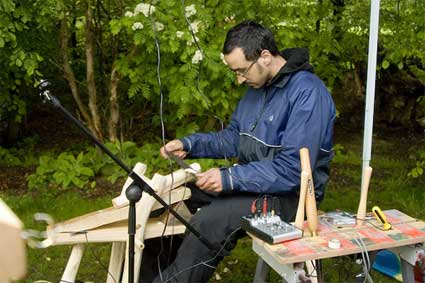
Image Lovebytes
I think for all of us it’s a welcome change from sitting behind a screen the whole time – these physical processes are a great compliment to programming and electronics; and they still require a similar kind of focus and discipline. It is quite exhausting, you need a lot a focus to keep the beat in time as well as make a good carving, in this way it becomes quite mediative. Sharpening the chisels and preparing the timber are all equally demanding skills to learn.
Can you tell us something about the wooden objects produced during the performances? Which kind of objects are there? And what do you do with them once the performance is over?
We have a box full of various objects; ranging in description from ‘chair leg’ to ‘fire wood’, or specialist ‘rolling pin’. Occasionally we have a look inside & discuss what we should do with them. We did make a chair with Mike about the only truly useful thing we ever made. The latest idea is to make some kind of flat pack, or player. Watch this space. You can see what we decide to do with them at The Piemonte Share Festival, 11 – 16 March 2008.
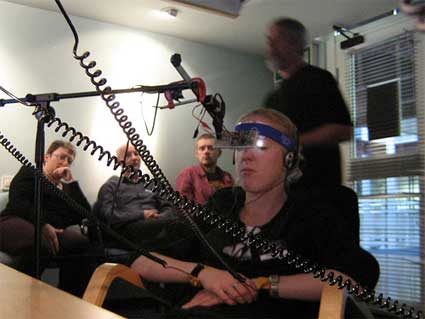
Documentation of first ENKI event at the Museum of Science and Industry Manchester, 7th October 2006
You are also interested in bio-digital medicine. That sounds very different from a project like iLog. Can you explain us what it is and how you started to be interested in this field?
Well this is my own personal project, although I have always working with biology or technological experimentation in some way; with ENKi I decide to humanize what I do. This was a decision to move into medicine and treatment technologies. Really its the same things that we work with in the owl project; looking at how technology is consumed and sold. The notion of bio-digital medicine is just one example in hundreds, of how science, or even the suggestion of science is used, and misused to sell ideas. Faceless corporations feed on our anxieties, our basic need to feel contentment or feel complete. I find it interesting that, just as some people turn to religion, others will look to technology or science to provide answers and solutions.

ENKI uses the bioelectric information from an Electric Fish to trigger human Brain-wave Entrainment. It generates sound and light pulses to induce a state of relaxation similar to the way traditional relaxation systems work, but the electric communication signal comes from an electric fish rather than a chip.
Did you test the system on other people? How do they react?
So far we have tested it on about 40 volunteers,most of them members of the public who had no prior knowledge of the project. We did this in the context of the Manchester Museum of Science and Industry; people enjoy the experience generally. I was surprised at the range of people who were up for it!
By this point I had started working with Greg Byatt as a collaborator. He has experience of using this kind of technology and administering similar treatments professionally. Greg has equipment which can monitor your physiological state and a brain-wave visualiser (EEG); we were trying to measure results this way. We only really came to one solid conclusion. We had to do more tests.
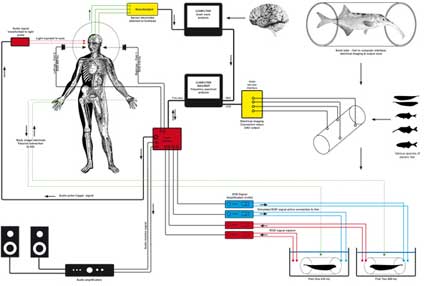
Isn’t the idea of putting one’s “brain-wave entertainment” into the fins of an animal scary? Do you feel that people would trust any other electronic device more than a fish or any other type of animal?
That is a good question. It’s an exciting notion this whole idea of “wet-wear” interfacing – but not something that should be taken lightly. I don’t like to be on my own if i am doing a test run, and yes I find it very unnerving. I never quite got used to the idea of connecting strangers up to electrodes and the fish. I also worry about the fish. The fish needs to be content and ‘happy’ for this to work.
In my opinion that most of these commercial devices are made by various humans all of whom have different intentions and issues, namely cost efficiency; and so effectively using quite crude means; cheap microchips. The Black Ghost knife fish is the result of millions of years of evolutionary refinement; but you could still say the same of micro chips.
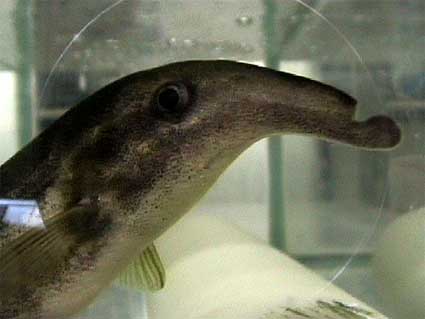
A Down poker
Is that project completely developed or is it still a work in progress?
It’s in progress. I started working with “electrogenic” fish in 2005; ENKI technology was the title I gave it in 2006 when I was in residence at ENSAD in Paris. This was the point I realized I could create a treatment technology that might actually be functional. I had a bit of pressure to actually finish something and so launched the basic concept of ENKI technology. The funny thing was that reflecting on it now – that just marked a new beginning. (It took a year just to convince the director of Pepiniere that it was in fact a real project and not some conjecture in science fiction!). Coming to think of it I have never really finished anything, I am much more excited by the notion of continued experimentation. I don’t want to finish discovering. The more I work on ENKI – the more things there are to do and try, it keeps opening up. There are always more questions.
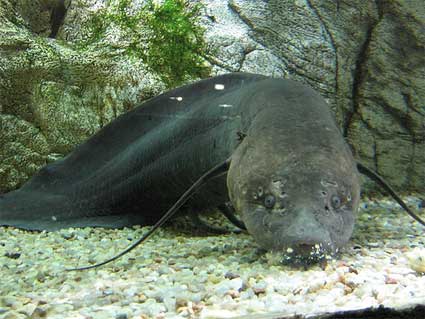
What is there left to achieve? And how much have you learned about cross-species communication?
There is still a lot to achieve. The ‘treatment’ side is just one layer of the onion. I started the project with the aim of communicating with the fish, generating an electrical signal and transmitting this in the fish in the tank, to the fish. Then I watch the the fish, looking for behavioral ‘interactions’ with the electrodes – generally if there is an electrical (connective) change to the electrodes, the fish is aware of this and investigates the electrode by swimming near it and around it (motor-probing responses). I also listening for a ‘chirp’ response. The ‘chirp’ response is a subtle modulation of the Electric signal, a specific fluctuation in the wave. The ‘chirp’ is used during like species interaction and communication. This is closer to the idea of language we have.
Experimentally there are factors which make this difficult to measure – The fish learns to associate the vibrations created by me entering the studio & opening the tank with a food reward. So any approach to the tank needs to be made silently, and the fish needs to be ‘conditioned’ to learn this over a long time. As the project progressed I became more interested in communication as something closer to an idea of commune. For the fish I see the communication signal they make more as a deep expression of self; a projected physical extension of the fish body, rather than ‘language’ in an anthropological sense. This communication is happening at a more primal level. In terms of the ENKi project I am thinking about this as a biological, or physiological connection between living organisms.
I recently discovered that I might be having a problem with what is known as ‘superstitious’ behavior in the fish; if I was a scientist in the academic sense, this would be a serous flaw in the project; something to fix, but for me it was a fantastic turn, giving the project a new angle all together. Its now becoming an experiment into animal Psychology, not just electro physiology. I don’t want to say too much about this next phase but next year the project will look quite different.
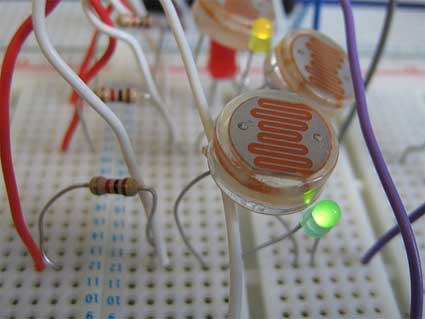
You recently developed the Opto-acoustic modulator and used it for an interactive work at FACT and Liverpool John Moores University for the National Science and Engineering Week. Can you give us more details about this interactive piece? How does it work? What were you trying to achieve with this project?
The commission was to create and interactive art work that used something other than keyborad or mouse. I was determined not to use a video camera either. The the Opto-acoustic modulator basically turns sound-waves into light-waves. It can take 10 audio channels and convert these into “AM” transmissions through 10 Light Emitting Diode arrays. I am fascinated by the notion of ‘Amplitude Modulation’ sending data using light waves. The idea was to use ‘Hyalite’ salt crystals, to broadcast sound through their ‘ionizing’ ambient glow. You interact with the light and can detect the data as sound using wearable sensors. Additionally, using Steve’s ‘muio’ interface again, 8 light sensors detect movement around the crystals using a lens and light sensor (based on the idea a simple biological ‘camera eye’) these feed into MAX MSP controlling a soundscape.
I read on your statement page that you are currently “working on new experiments relating to the creation of life through growing crystals electrically on volcanic stone, hunting for Moss bears (Tardigrades; Fresh water extremophiles) and training Planarian worms. ” Could you already tell us a few words about these experiments?
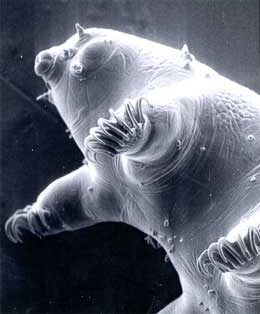
I have been researching the work of William Cross for quite a while, and finally decided that I needed to recreate his experiments (with a few modifications) It’s quite interesting trying to work out what he did – the only way to know is to recreate it. In 1837, he found these creatures “Acari electors” as he called them infesting an experiment, he believed that these things “spontaneously generated” within his experiment, several eminent scientists of the time recreated the experiment with the same results! My experiment is basically a recreation of this experiment, augmented with a little more technology – with the aim of capturing this phenomena of electrochemical abiogenesis. The only problem is the experiment has to run for many months.
I am interested in all sorts fresh water microscopic life; its a great 19h century tradition. With a decent microscope, you can take any roadside moss cluster and explore the interstitial oceans of liquids trapped between damp moss filaments. Here you might be lucky enough to find a Moss Bear ( “Tardigrade” ) an obscure form of extremophile that lives in moss. Believe it or not, it really does look like a bear! This in its self was a reason for laboring days over a microscope just to see if it was real! They don’t fit into the zoological classification system, and have been given a phylum of their own. It is believed it is able to survive space travel, and at this moment a small space capsule orbits the earth containing some “Tardinauts” (its hard to compete with that) I simply enjoy looking for them. I like to go looking for moss growing in all kinds of areas, from urban waste lands, to the Peak District. “Tardigrades” are able to survive about 120 years in a dehydrated state; I was sifting through very old moss samples from Manchester Museum to see if I could reanimate 100 year old dehydrated Moss Bears. apparently it is possible. I had a lot more luck looking for the living ones. Unfortunately my one Planarian worm recently went missing in the tank. It is 8mm long, and I dont have the heart to keep it in a petri dish. I am not sure where it is.
Is there any artist or researcher whose work has been particularly inspiring for you?
I don’t know where to start! Louis Bec for sure. I am really into what SymbioticA have been doing over the past few years, and what they are doing for the “Bio-art” movement. Otherwise, at the moment I am looking at the work of William Bebe. To be honest – I have been trying to read a lot more science fiction lately, particularly 19th century science fiction, and science writing. Often the science fiction tells you a lot about the popular understanding of science at the time. More importantly, its a good antidote ploughing through contemporary research papers.
Thanks Antony!
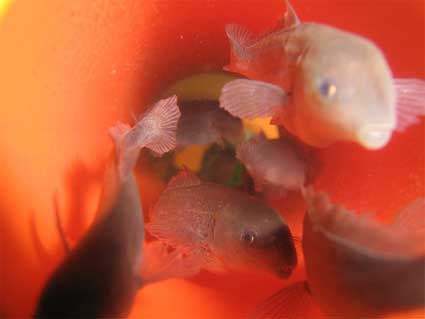
Related: El Niuton has a slideshow dedicated to the work of Simon Blackmore.
Today, as part of The Bilderberg’s Future_Brunch 101 salon at Transmediale, Francis Hunger gave a presentation about The Setun Conspiracy which received an Honorary Mention last night at the Transmediale ceremony (details about the winning projects in this press release PDF.)
And for whatever this is worth, it was my favourite work among the nominees…
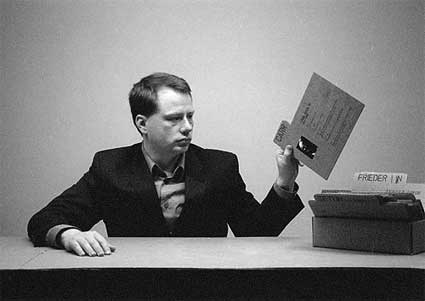
The SETUN computer was developed in 1958 by Nikolai Brusentsov and his team at the Moscow State University. SETUN is based on ternary logic (-1, 0, 1), which distinguishes it completely from the usually binary operating computers of the present and the past. While the binary logic just allows two states yes (1) | no (0), the ternary logic has three different logical states: yes (1) | no (-1) | both or maybe (0). Western computer scientists tried to create such a ternary computer in the following years but never succeeded.
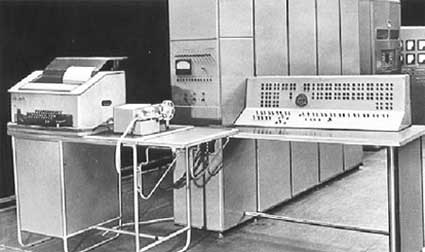
“Setun” trinary computer developed at Moscow University (image)
Francis Hunger’s work consists of several elements: the archive research collected since 2003, representation of the results in form of an office since 2005 and a book with essays and interviews, which is is just out from the printer*.
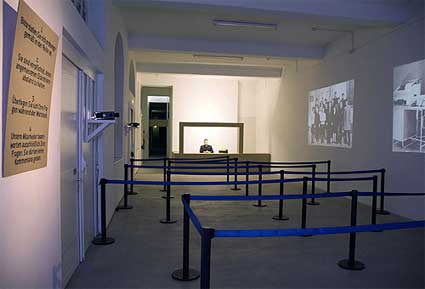
Installation view
The installation puts visitor in an office situation with a waiting line of rope and stanchions that lead to a cardboard office, reminding the high security places where human behaviour gets directed. The waiting line are meant to have visitors experience the whole space, getting to watch 2 images projected on the wall (one of the computer, another one of the team who developed it) and read the list of rules that instructs their behaviour: people are allowed to ask questions only, not to make comments; they should access from the right side; they should keep a discretion distance since it is an individual session with only one or maximum two persons allowed to come near the performer at the time. Any visitor who would not respect the rules will be dismissed.
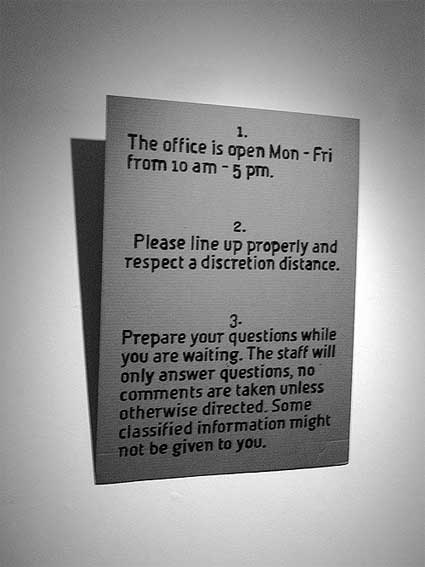
It is both a “discipline and punishment” situation but also a playful one.
After having done extensive research about Setun (exchanging emails with Nikolai Brusentsov, extensive readings and research for documents written about the computer, etc.), Francis’ concern was “What is the best way to distribute knowledge?” A text could of course transmit the knowledge but wouldn’t produce the same situation, that level of interactivity. Throughout the “interactive” performance Hunger is the only one who has the knowledge. If people ask the right questions they might discover whether the Setun conspiracy is a fact or a fiction.
Hunger than read a text that has influenced a lot his ideas about interactivity. It is a statement that Alexei Shulgin wrote11 years ago and which addresses the question of interactive art:
Looking at very popular media art form such as ‘interactive installation’ I always wonder how people (viewers) are excited about this new way of manipulation on them. It seems that manipulation is the only form of communication they know and can appreciate. They are happily following very few options given to them by artists: press left or right button, jump or sit. Their manipulators artists feel that and are using seduces of newest technologies (future now!) to involve people in their pseudo-interactive games obviously based on banal will for power. But what nice words you can hear around it: interaction, interface for self-expression, artificial intelligence, communication even. So, emergence of media art is characterised by transition from representation to manipulation.

The Setun was what was called at the time an “electronic calculation machine”. For Nikolai Brusentsov, the ternary system was the most logical solution. It also turned up that it allowed to build the machine using less units and it was much more reliable than other computers made at the time. 50 copies were manufactured which, again, was quite an achievement for the time. It was used for agricultural calculation, nuclear power plants, for teaching programming, etc.
Here’s some more info found on the Soviet Computing website: Unfortunately, after the Setun-70 project, Brusentsov’s lab was relocated from the Computer Center at Moscow University to a windowless attic in a student dormitory and was deprived of any serious support. The new university rector considered computer design a pseudo-science. Brusentsov’s original Setun computer, an experimental prototype that had faithfully worked for seventeen years, was barbarically destroyed and carted off to the dump. Brusentsov’s laboratory coworkers took the Setun-70 to their attic laboratory and used it as a basis for developing the Master Work Station – an educational computer system.
To this day, Brusentsov maintains that the trinary system is superior to binary.
The artist is actually not happy with the title of his work. The word conspiracy evokes two ideas, it also evokes the difference between telling History and telling a story. There are conspiracies that exists. For example, the conspiracy against President Allende in 73 which is now sustained by well-recognized facts and sources which can be named. And then there is conspiracy that supports ideologies and simplifies world views. In the performance, the word “conspiracy” is used to get people interested in the work.
One year before Setun, on October 4, 1957 Sputnik satellite went up which triggered the “Sputnik Shock” in the US. They suddenly getting interested and preoccupied by this success of Russian technology. The conspiracy that Hunger constructed was that the Russians didn’t want to show the Setun computer but the US tracked down and found a traitor ready to talk to them about the computer.
More info about the book:
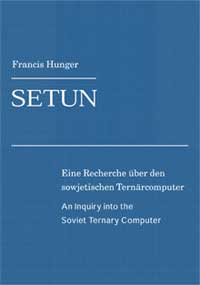 *SETUN. An Inquiry into the Soviet Ternary Computer. Eine Recherche über den Sowjetischen Ternärcomputer. Institut für Buchkunst Leipzig. German/ Englisch, ISBN 3-932865-48-0
*SETUN. An Inquiry into the Soviet Ternary Computer. Eine Recherche über den Sowjetischen Ternärcomputer. Institut für Buchkunst Leipzig. German/ Englisch, ISBN 3-932865-48-0
The work deals with the production and representation of knowledge, the historical and ideological aspects of technological development, and it aims to create an understanding of the intertwining of current technological and social developments using a historical perspective. The book makes original Russian sources available in English and German language and is accompanied by an original essay investigating into the relations between the “communist” Easts’ and capitalist Wests’ technological development. While the book aimes to provide a basis for further research, the artistic work tries to involve visitor and artist into what can not be expressed within the realm of theoretical discourse.